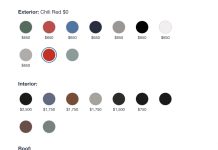With the demise of the Ford Crown Vic (and its sister ship, the Lincoln Town Car) there’s only one choice left if you’re looking for a traditional American-style roller. 
You know, something substantial – a big (and heavy) sedan available with a big V-8 engine that comes standard with a big personality.
And which also’s still affordable.
It’s built by Chrysler.
WHAT IT IS
The 300 (and its corporate cousin, the Dodge Charger) is an American brand rewind on what has – unfortunately – become a mostly European concept . . . and a rich man’s ride:
It’s a large, rear-drive-based sedan very similar to something like an E-Class Mercedes or BMW 5, but with a starting price under $28k ($27,470 actually) instead of closer to $50k.
You can buy an AWD-equipped 300 Limited for $32,470 and a V-8 powered 300 C starts at $38,470. There’s also an ultra-performance SRT-8 version of the 300 (reviewed separately) that carries an MSRP of $47,470.
The 300 has very few direct competitors because of its combination of layout/features/power and price. The Cadillac CTS is somewhat similar, being American and rear-wheel-drive (AWD optional). But it’s significantly smaller – and you can only get a V-8 in the ultra-performance (and ultra-pricey) CTS-V. Most everything else that’s comparable in size and price is either FWD-based and Mrs. Doubtfire-ish (such as the Toyota Camry/Avalon) or luxury-branded and much more expensive, like the BMW 5 or Benz E. 
The only car out there right now that’s a plausible cross-shop is the Hyundai Genesis. It’s also a big lunk of a car, also based on a rear-drive layout and comes with a strong V-6 and offers an even stronger V-8. But nice as it is, it’s also considerably more expensive than the 300, with a starting price of $34,200 ($44,500 for the V-8).
Like I said… .
WHAT’S NEW FOR 2012
A new eight speed automatic transmission with drive-by-wire “E-shift” can be ordered with the V-6 engine and for the first time, you don’t have to buy the optional V-8 to get AWD. The new Pentastar 3.6 liter V-6 produces V-8 power – at least, enough power (292 hp) to handle the additional weight of the AWD gear and still be quick (0-60 in 7 seconds flat).
Also new are two S trims, one with the V-6, one with the V-8. 
WHAT’S GOOD
What’s not? It’s big, brawny and wonderfully put-together.
A touch-screen control system that’s actually easy to use. Optional heated steering wheel that doesn’t just get warm. And heated cup-holders that get hot. (Cool, too.)
For the money, nothing can touch it.
Hell, forget about money. It’s one of the nicest big sedans you can buy right now – period.
WHAT’S NOT SO GOOD
I came up with one thing – the “E-shifter” that you get with the new eight-speed automatic. It makes a simple function fussy. Throw it in the Woods.
It’s the only thing I did not like about the new 300.
UNDER THE HOOD
Standard equipment in the 300 is a very impressive 3.6 liter V-6 that produces 292 hp. It’s paired with either a five-speed automatic or (optionally) a new, more efficient eight-speed automatic. 
For a little perspective, this engine is more than 100 hp stronger than the original (2005) Chrysler 300’s base 2.7 liter V-6 (190 hp) and so equipped, the 2012 300 is much quicker: Zero to 60 in 7 flat, about two seconds quicker than the original base model 300.
But what’s really impressive is the new 3.6 V-6 gives you all that power and significantly better gas mileage, too. With the new eight-speed automatic, the 3.6 equipped, RWD 300 is capable of an EPA rated 19 city and 31 highway vs. 18 city, 26 highway for the old limp noodle 2.7 V-6.
It also gives you all that for less than $28k to start. The Hyundai Genesis does offer a standard 333 hp 3.8 liter V-6, but its starting price of $34,400 is almost $7k higher than the 300’s base price.
The other nice news is you can order AWD if you like with the V-6. Last year, AWD was only offered with the optional Hemi V-8 in the more expensive C version of the 300, which carried a starting price of $38,170 vs. $32,470 for a 2012 Limited w/AWD – saving you $5,700.
The Hemi C, meanwhile, is up to 363 hp (about 20 hp more than the original 300 C) and good for 6 second 0-60 runs. Here the matchup with the V-8 Genesis is closer, powerwise (4.8 liters, 378 hp) but the Chrysler kills it on value for the dollar. The V-8 equipped Genesis starts at $44,500 – a solid six grand more than Chrysler asks for the brawny 300 C. 
Go rear-drive or AWD. A five-speed automatic is the standard and (for the moment) only transmission choice. Hopefully, Chrysler will offer the eight-speed with the V-8.
Eight plus eight would be great!
It’d also probably help the 300 C’s fuel economy – which with AWD is a hungry 15 city, 23 highway.
ON THE ROAD
The Hemi C gets most of the press but if you’re shopping a 300, don’t neglect to try the V-6 version, especially with the new eight-speed transmission.
Even with the extra weight (which actually isn’t much – only about 30 pounds – or 4,029 lbs. vs. 3,999 lbs. for the RWD V-6 300) and drivetrain inertia, that 292 hp makes itself felt – and heard. In a good way. The 3.9 Pentastar has a nice growl when roused – and it will spin to 7,000 RPM with enthusiasm. Even better, thanks to the new eight speed’s extremely favorable gearing, you can trundle along at 60 MPH with the engine running around 1,300 RPM or just above idle speed. This is a big part of the reason for the V-6 300’s excellent fuel economy potential. 
The only fly in the pie is the stylistically attractive but functionally awkward (at least, to me) E-Shift electronic shifter that comes with the eight-speed automatic. Like a growing number of premium (and near-premium) cars that have a similar set-up, there is no mechanical gear selector – or even any mechanical connection between your right hand and the transmission. It’s all drive-by-wire and computer-controlled. On the console there’s a stubby, toggle-style shift handle with a thumb button. You’re supposed to depress the button then toggle the lever back and forth to select the various ranges. Like the other electronic/toggle shifters I’ve tried, there’s a slight delay between the action of your hand and the transmission moving into whatever gear you wanted. You also don’t have the tactile, physical feel of engagement. I am not a fan of these electronic gear shifters. They strike me as Rube Goldberg devices that make what ought to be a simple function more complicated than it needs to be. I’d also be concerned, as a potential buyer, about what happens down the road when this unit develops a hiccup or just craps out completely. With a mechanical gear selector, a by-the-side-of-road repair is usually doable. With this E-Shifter deal, you will probably have to call a truck. 
The Hemi C and its 363 hp V-8 still delivers the goods the old-school way, through a conventional (mechanical) gear shift selector. It also still uses the same five-speed automatic as last year (and which is still the base transmission with the V-6 300). There’s nothing wrong with this transmission by any means. And the 5.7 liter Hemi pours on the power at the slightest depression of the pedal. Of course, that will also leave you pouring in the gas, in large quantities. Unfortunately, even when you try to drive it gently (not easy, as this car begs to be taken off its leash) the best you’ll do, MPG-wise, is low-mid 20s. I wonder how much the situation would improve if Chrysler paired the big V-8 with the new eight-speed transmission? I suspect the tighter spacing between gears and the deep overdrive gearing on top would boost the Hemi’s overall numbers by 2-3 MPG, enough to make a noticeable difference.
Maybe next year?
On the 300’s optional AWD system: Unlike most of the AWD cars on the market – especially those in the 300’s price range – this system is rear-drive-based, not front-drive-based. What that means is the engine’s power normally goes to the rear wheels. Only when the rear wheels begin to lose traction will the system begin to kick some of the power to the front wheels. From a performance/handling point-of-view, this is an advantage because the front wheels don’t (normally) have to do two things at the same time – that is, put the power down and steer the car. The weight of the driveline (engine, transmission, driveshaft, axle, etc.) is also spread out more evenly than in a nose-heavy FWD car, which has its engine and its transmission (its transaxle) hanging over the front wheels.
That plus two tons plus ample power (either engine) makes the 300 one of the most secure-feeling, road-commanding cars on the road. Even better, you don’t have to be a rich man to enjoy what is increasingly a rich man’s privilege.
The styling tweaks to the 300 (new for 2011) toned down the Luca Brasi malevolence of the original 300, subtly changing the demeanor from Enforcer to Don. A new front clip and smaller, horizontal slat (vs. egg-crate) grille with Audi-like LED surrounds (and not as tall and blocky) headlight assemblies soften the scowl. It still looks tough, but more executive tough than street tough.
Inside, it’s downright opulent. Top-drawer materials and a classy layout. Notable highlights include the soft blue aura of light that surrounds the main gauge pod, the optional heated steering wheel that really cooks – and the heated cupholders in the console that will do more than just warm your coffee. You can switch to cool, too.
Chrysler makes no secret about its determination to be considered a full-on premium brand – just as Chrysler cars once were, many decades ago.
This thing stacks up very favorably against $50k cars like the Mercedes E-Class or BMW 5. And though I am a fan of the new Hyundai Genesis, the 300’s interior is just nicer.
It’s also got what may be the best – that is, most user-friendly – touch-screen interface in the business right now. Simple icons on the center stack LCD “main page” that appears at start-up tell you what’s what at a glance. You want to turn the seat heaters on? You click the icon – and on they go. No mouse to torture you (or drive you to distraction). It’s seamless and best of all, self-explanatory. This is technology I can embrace because it makes things easier, not more complicated.
Controls for the AC/heat are likewise eminently functional – no manual-reading required.
And then there’s the room. Almost 42 inches of front seat legroom – and 40.1 inches of rearseat legroom. How much room is this? It is about an inch more front seat legroom than in a 2012 Mercedes E-Class (41.3 inches) and – wait for it – nearly five inches more than the Benz’s brutal back seat accommodations (a miserable 35.8 inches). The 300 also beats the Hyundai Genesis, which has 40.4 inches up front and 38.6 inches in the rear. 
Mind, both these cars are considerably more expensive – the Benz, a lot more than merely considerably. It starts at $50k. And that only gets you a V-6 and RWD. To get a V-8 and AWD you are looking at $59,790 – a full $20,000 more than the V-8 300 with AWD.
Hell, you can buy a 300 SRT-8 with a 470 hp 6.3 liter version of the Hemi and all the toys and still be under $50k – that is, under the base price of the entry-level E-Class with just a V-6.
And with five inches less legroom for your poor passengers.
Personally, I’d only have two concerns about buying a 300. The first is the health (and future prospects) of Chrysler, now a subsidiary of Fiat. The company seems to be doing ok – and Fiat seems to be committed to Chrysler. But there is a question mark in the air – and that brings me to the second thing: Long-haul durability. Pre-Fiat Chrysler had some quality control issues, which no doubt were related to razor-thin profit margins and cost-cutting. Then came the bankruptcy – and now, Fiat’s infusion of cash. Hopefully this means that current Chrysler stuff hasn’t been cheaped out on in places not yet apparent. And to its credit, Chrysler is giving customers a five-year, 100,000 mile warranty on the powertrain. However, the rest of the car is still only covered for three years/36,000 miles. Mercedes gives its buyers four years/50,000 miles on the whole car. Hyundai does even better by its buyers with its industry-best five-year/60,000 mile “whole car” coverage – and ten years/100,000 miles on the powertrain.
Historically, Chrysler had a reputation for boldness. Its current cars certainly fit the bill. It’d be even ballsier if Chrysler offered an equally ballsy warranty package.
That’d really kick the Big Name players in the balls.
THE BOTTOM LINE
Chrysler may be owned by Italians, but it still makes the best American sedan on the road.














I’ve always wanted one. ever since 2005 😉
Great review, I’d love a heated steering wheel!
Thanks, Brandon!
Are the Crown Vic and Town Car being canned for 2012/2013?
They are already canned. 2011 was the last year.
In so many areas, the route to success is finding a niche and being extremely good at it/monopolizing it to the hilt. It seems that the Chrysler 300 has been doing just that. No one else has a big RWD car with a V8 for less than $50K.
Not anymore! (The Crown Vic/Town Car being the last of the direct competition).
I just hope CAFE doesn’t kill the 300, too.
If/when they team the V8 with the 8 speed transmission, this car will be almost irresistible. Think my first choice though would by the Charger…..”if” they will sell the hemi package in “plain wrap.” No wings, or decals etc.
I drove a rental 2011 300C. It was solid at high speeds and delivered 26 mpg at speeds at 80-85 mph with occasional bursts to 100 mph. For a large car, handled and steered extremely well.
I dig it!
And that’s the V-6 version I have in the driveway right now. The Hemi C is nice, but the 3.6 V-8 makes paying for the V-8 unnecessary.
And you’ve just got to try the heated wheel…
What are you saying man? Speed does not decrease gas mileage that much? I am sure you were wrong and were getting 31 mpg at over 80.
I got around 26 mpg at 80-85 mph. Sometimes I went above 90 and sometimes around 70, but overall that is what I got. If I had gone closer to 70-75, I think it would have been around 29-30. Aerodynamics and gearing come into play at those speeds, although speed doesn’t affect gas mileage that much. It would seem that you lose around 10% between 70 and 80/85 mph. Speed does affect gas mileage, but not that much.